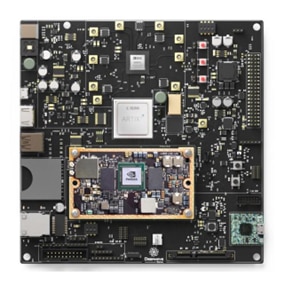为什么 Chromecast、Airplay 和蓝牙不能和睦相处?
有助于产品说同一种语言的硬件和软件
当工程师设计最新、最优的消费类电子设备时,兼容性就成了一个重要的话题,尽管这个话题很诡谲。如果您读过我以前的 DigiKey 博客,就会知道我是向后兼容的支持者,也是格式战的批评者。不过我也明白,关于生态系统的工程讨论往往归结为预算、技术、硬件、物流、编程、知识产权和规划。以 Chromecast、Airplay、蓝牙和 Wi-Fi 为代表的无线通信就是很好的例子。
 兼容 802.11 a/b/g/n/ac、蓝牙 v4.1 GPIO、I2C、SPI、UART 和 USB 5Gbps 的射频收发器(资料来源:Deepwave Digital、NVIDIA 和 DigiKey。)
兼容 802.11 a/b/g/n/ac、蓝牙 v4.1 GPIO、I2C、SPI、UART 和 USB 5Gbps 的射频收发器(资料来源:Deepwave Digital、NVIDIA 和 DigiKey。)
Chromecast 和蓝牙的应用几乎与 Wi-Fi 一样广泛。然而,Airplay 总是不能与其他设备好好配合。苹果公司已经放宽了对第三方使用其专有无线通信协议的限制,但其协议在很大程度上仍然是一个封闭的生态系统。另外,谷歌和蓝牙技术联盟 (SIG) 走的是则是开源路线,使得大量硬件和软件都能集成到这两个不断发展的生态系统中。
问题来了:工程师以及消费者能否通过提供可与所有这些无线通信技术连接的产品而胜出?
无线通信技术的共同点
就核心而言,所有无线通信技术的工作方式都是相同的。发射器接收电子信号并将其转换为无线电波。然后由接收器接收电波,再将接收到的信息转换成电子信号。收发器是既能发送又能接收这些信号的设备。Wi-Fi、Chromecast、Airplay 和蓝牙的不同之处在于这些信息是如何被转换、编码和传输的。从本质上讲,这些协议的对话方式相同,但语言不同。
从硬件角度看,工程师选择兼容这四种无线通信协议的不同工作频率的发射器,就能轻松设计出能与所有这些协议互动的消费电子产品。换句话说,确保产品能与所有协议互动面临的主要挑战来自软件方面。
是什么将 Wi-Fi、Chromecast、Airplay 和蓝牙生态系统区分开来?
蓝牙是一个独立的系统。蓝牙系统用 2.4 GHz 频段让附近的电子设备相互通信。传统蓝牙限制为两台设备之间的通信,但数据上限为 3 Mbps。低功耗蓝牙 (BLE) 顾名思义耗电量较低,但能让多台设备同时相互通信。BLE 的缺点是数据传输速率上限为 2 Mbps。工程师在设计消费电子产品时,有可能会选择兼容蓝牙但不兼容 Wi-Fi、Chromecast 或 Airplay 的收发器。
具有讽刺意味的是,Wi-Fi 是 Chromecast 和 Airplay 的核心;这些协议都在 2.4 GHz 和 5 GHz 频段工作。这两种相互竞争的技术借助 Wi-Fi 实现了多个系统可在同一网络上通信。这种共性就是为什么有各种软件解决方案可以让 Chromecast 设备与 Airplay 设备通信,反之亦然,而无需进行硬件扩展。这一共性也解释了为什么任何兼容 802.11 a/b/c/g/n 的收发器理论上都能兼容 Wi-Fi、Chromecast 或 Airplay 兼容。不过,这种收发器不一定能连接蓝牙。Wi-Fi 6 的带宽上限约为 9,600 Mbps,Airplay 约为 54 Mbps,Chromecast 为 60 Mbps。
Chromecast 和 Airplay 的主要区别在于,当传输数据流时,谷歌的技术会指示设备直接访问数据流。而 Airplay 设备则是先采集数据流,然后将音频/视频数据传输给设备。这就是为什么在使用大多数 Chromecast 功能时,可以关闭安卓手机;而使用所有 Airplay 功能时,苹果设备需要保持开启状态。换句话说,Chromecast 设备就像一个遥控器,而 Airplay 就像一个有线电视盒。
结束语
值得指出的是,由于 Chromecast 设备可直接访问流媒体,因此与 Airplay 或蓝牙相比,往往能给用户带来更好的视觉和音频质量。因此,确保设计与 Chromecast 兼容会是不错的选择,除非你设计的产品直接面向苹果和/或蓝牙社区。
有关收发器技术及其兼容无线系统的更多信息,请访问 DigiKey 的产品列表。

Have questions or comments? Continue the conversation on TechForum, Digi-Key's online community and technical resource.
Visit TechForum








 中国
中国